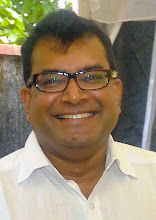– amalgamation and DE politicization, along with teeth to manage their
affairs and be accountable to the Country for their actions.
Caliber
of workforce @ DWC from top down
As is typical of public service, the
staff in different grades follow established practices, that place no emphasis
on background, aptitude, dedication, dependability. One therefore has staff on
the same pay scales, but judged differently, do different tasks, and if their productivity
was evaluated, have insurmountable gaps in their performance levels.
It is impossible to standardize, but in
the private sector, many positions are earned from merit, and not from years of
service, and so there are many routes to the top, and promising candidates can
be fast tracked. It is almost impossible to do so in the Public Sector. As a
result extremely competent people are lost in the woodwork, getting no
recognition, or promotion, who have to bide their time, whereas incompetent
boot lickers get to the top.
Then you have many who have been given
jobs, through political connections who are really unsuitable for this type of
work, and are in short, a burden to the department and there is presently, no
means of eviscerating them from service.
Then you may have heard of the old
adage, that all the parks are outside of the Western Province, but 25% of the
workforce is in the Western Province, a wholly unacceptable situation, where
the staff for example in the DWC head office in Battaramulla are no different
in quality to any other staff in Govt. departments. That means, in plain
language, they can’t tell an animal from a human, and both visitor and animal
are treated worse than animals, and you can guess what that means.
It is therefore high time, that
professionalism takes over this department and a sense of pride in their vocation
is instilled. For that YOU MUST have a trained, professional and dedicated
workforce. You cannot have this if the department (DWC) is politicized. It is
actually easier to remove this department from the normal political
machinations, as it is the Wildlife and Biodiversity of the Country that these
staff are dedicated to protect. A new ETHOS can be established in a short
period of time. With capable people being promoted and given responsibility,
with a path to even Park Warden from the lowest laborer grade, a new
empowerment can take place, without which the goals of establishing the
guardians of our heritage cannot be met. Of course there has to be a public
debate on the benefits, before it is implemented, to give rationale to.
This therefore quite obviously warrants
a training establishment, with clear guidelines and teaching as well as
continuous professional education to keep all abreast of the latest technology
in protection and safeguarding of the species.
The
interaction with Law Enforcement
Another significant problem faced by the
DWC, is their interaction with the local police force. After all the poachers
in villages have connections with the local police, and so when they are
caught, prosecution is somewhat compromised, and there is no swift justice, and
often the worst offenders know they can get away with warnings or some form of
plea bargain. This is NOT good for prevention, and notice to the community that
poaching, traps, and other forms, used by farmers and villagers to kill animals
or maim them even in cases of intrusion into fields, will not be tolerated.
So different means like a special court
should be established for this type of crime that does not get the local police
involved. You will immediately notice a drop in poaching, when the habitual
offenders realize the game is up, and it is not a proposition worth pursuing.
Here too change can take place immediately.
The
construction and maintenance of the Electric Fences
There are hundreds of kilometers of
fencing in place at present. Many have been constructed very poorly, with the
contractors, in league with some DWC high officials, who have effectively
pocketed much of the allocated funds. It is not difficult to have the
construction side of it managed and approved centrally to required standards.
The maintenance of fences have now been
handed over to the CSD, which was established to protect villages during the
conflict, and now they are used to clear the undergrowth on both sides of the
fences periodically and maintain the fences and repair them when broken.
Elephants are becoming increasingly clever in their ability to break fences,
and this task is becoming an even more important issue locally in affected
areas.
The fact that DWC staff have to oversea
CSD staff in this maintenance function does create conflict, as the local
village is also involved in the complaint, and so with three parties to the
solution, there inevitably results in HUMAN HUMAN conflict that sometimes needs
to be arbitrated owing to the numerous disputes.
Part of the problem that has been
recognized is that many Elephant Corridors have been blocked by these fences
and there are experts, who can be consulted in how and where to place fencing
in order to minimize HEC, and it is shown that fencing the villages in and not
fencing the elephants out works better, despite the apparent disagreement from
villagers who wish to encroach.
Due to the Elephant Population living
outside protected areas for the most part, the extra trained manpower is
required to cover the increasing frequency of conflict. This justifies the
training and the professionalism I have referred to earlier in establishing a
training school prior to being assigned responsibilities.
The public at large are blissfully
unaware of the scale of this need, as it is localized and the Media do not
bring out the frequency of occurance. With limited resources allocated to the
Department, it is difficult to step up the game.
Half
of the places of Archeological Interest lie in protected areas
While I have mentioned the need for the
Forest Department and DWC to work together or joined, instead of being part of
two different ministries, it makes no sense that the Archeological sites are
administered by a further Ministry, where this can also be amalgamated with the
aforesaid two so that our heritage is preserved as well as our Biodiversity in
one swell swoop. The officers of the DWC must understand Archeology and their
preservation and this too will be built into the training curriculum, as they
will then know how to identify, and protect these locations within the
protected areas, from looters, treasure hunters, and desecrators. One can
understand the need for the upgrade of this service.
There are 250,000 areas of archeological
interest in Sri Lanka, which makes it the world’s highest concentration of such
sites. The fact that 95% are not secure and open to raiding, is unimaginable
and if resources are in short supply, de-mobbed forces personnel could be used,
as this is a further employment opportunity for people in rural areas.
To begin with the Security Forces should
establish a separate section for this task and then gradually over a few years
move it out into the DWC as a security unit of the DWC. Later, amalgamate the
CSD into it and have a security force that guards the property that come under
their jurisdiction, allowing the trained staff to take care of the other
responsibilities of all protected areas coming within their purview.
Resource
Allocation to the DWC
It is increasingly evident that in order
to do their job according to the law, the DWC should be allocated much more
resources, from the money they earn from tourism that presently goes to the
Treasury, from whom allocations come few and far between, and there is no
method in the way it is distributed.
It is not just personnel that is in
short supply, it is the equipment needed to carry out their duties. Be they
vehicles, or drones. None of this is currently forthcoming as there is no clear
understanding by self-serving politicians, who are not concerned with animals
that don’t have a vote.
This then is a further reason to take
politics out of this task, and like the Judiciary, call this act of protecting
the Biodiversity of Sri Lanka, the Fifth
Estate, that is given clout and independence to carry out their duties, and
their independence can also come with a Revenue Raising Mandate, that is left
for them to administer, as there are many such options that are not considered
owing to a lack of direction and professionalism within the service at present.
Permission has to be granted from people
who don’t know anything about the subject, even if toilets are required in the
National Park Entrances. Tourist have NO facilities even to take cash from an
ATM, or the convenience of paying by credit card, due to this public service
mentality that is NOT conducive to a tourism oriented economic growth. Those
who pay don’t have any say.
A properly managed SERVICE in the format
explained here, will more than pay their own way in income that has yet to be
tapped, due to the inability of the present system to work as a profit center.
It is simply absurd for the DWC that earns so much for the Exchequer, that it
is not given the opportunity to do more. They know how to balance over
visitation and opening alternative locations, and not leave it to political
whims, to maximize the tourism experience, that is currently being ruined by
poor management and entanglement of local politicians in the smooth running of
the DWC.
You only have to look to India, that is
does a super job in managing their wildlife, for examples of this in action,
and look at Costa Rica that puts top priority to enhance their Bio Diversity
experience and product, as they know it is a WIN WIN proposition for the
country overall. In the end, if it does not benefit the citizens of Sri Lanka
there is no point in proceeding any further!
I have covered a whole myriad of points,
that with the experience I have gleaned from observations across the Country, I
know, can result in a better product, more safeguards for biodiversity, less
friction amongst players and benefit this Country enormously. We have not even
attempted the potential yet!
CONCLUSION
This is a working paper on the way
forward, to bring some ideas into the debate so we can end up with a
Biodiversity Masterplan for the future, the need today.
















